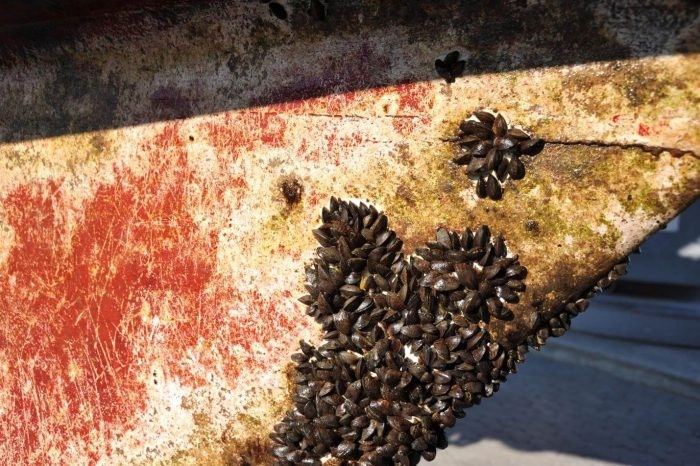Every day, thousands of commercial ships transit from one part of the world to another, keeping supply chains and essential goods moving. With lifespans ranging between 20 and 25 years, merchant vessels spend a great amount of time in the ocean, cruising through tens of thousands of nautical miles and sailing through countless marine ecosystems.
In fact, over 4,000 different types of marine species can attach themselves to a boat. These are generally classified as slime, weed, and shell fouling. If not treated with special coatings, these small organisms can accumulate on a ship’s hull and increase the vessel’s resistance in water, leading to higher fuel consumption, greater air emissions, and increased level of underwater noise. Furthermore, the sections of ships below the waterline become vehicles for the transfer and spread of aquatic invasive species such as zebra mussels, barnacles, and tunicates.

When marine species attach to ships, they roughen the hulls, which creates friction and drag through the water. This resistance causes ships to use more fuel and emit more air pollutants and greenhouse gases during their voyages. It is estimated that biofouling can increase a ship’s resistance in water by 20-60%, slowing it down and leading to an increase of 40% in fuel consumption.

The higher fuel consumption is not only bad for the environment. It also raises the operational cost for ship operators and, ultimately, for consumers worldwide who depend on marine shipping for access to goods and commodities. In-water friction caused by hulls and propellers fouled with marine organisms can also influence the levels of underwater noise ships emit in the marine environment. This can interfere with the frequencies that marine mammals (such as whales) use to communicate, feed, reproduce, and avoid danger, threatening their survival.
Although hull cleaning is part of the solution, it is an expensive and time-consuming process that must be repeated over time. If done incorrectly, hull cleaning can accelerate the transfer of invasive species. So, what about a lasting solution that keeps the hull sleek and prevents marine growth in the first place? That’s when antifouling paints come into play.
What are the benefits of Happy Wall’s antifouling paint?

Happy Wall’s antifouling paint is a special coating that is applied to the hull and propellers of a marine craft. The coating is used to slow down the growth of marine organisms such as barnacles, slime, algae, and mossy weed. Antifouling paint can prolong the life of your vessel while improving its speed and fuel efficiency. A smooth hull will have less drag and therefore use less fuel, saving you money, decreasing fuel emissions, and making the vessel faster.

In addition to antifouling, the coating prevents corrosion on metal hulls and propellers. Corrosion and fouling are interrelated. Bad corrosion resistance leads to the disruption of the paint film, hence the loss of antifouling properties. Poor fouling resistance also leads to corrosion due to barnacles cutting their way to the substrate and disrupting the film. Preventing fouling and corrosion extends the vessel’s life, increases efficiency, reduces operational costs, and reduces marine accidents and expensive repairs.
How to apply antifouling paints?
Begin by giving your boat a high-pressure fresh water wash to remove loose antifouling salt and calcium deposits. If you don’t remove this layer it can lead to blistering, delamination, or even poor antifouling performance. Once done, the surface should look clean and free from any contaminants. Sandblast the external surface to remove old coatings, heavy rust, and marine growth or mil-scales. Then, sand laminate these same surfaces to uniform the roughness and smoothen all the edges using sandpaper P80-P120. Before priming or applying antifouling, mask off the area to be painted.
Mix paint thoroughly with a stirring stick, ensuring that any settlement is mixed in. Then, prime the section of the boat that will be submerged in water with Happy Wall’s marine primer and let it dry completely for 4-6 hours. Apply two coats of Happy Wall’s antifouling paint and let it dry totally between coats. Finally, thin with Thinner.
Happy Wall’s antifouling coating is a win-win solution by preventing the spread of invasive species, reducing air emissions from ships, decreasing underwater noise, and preventing corrosion. Thus, the vessel is properly maintained, its life is extended, and it is ready for the seas for a long time.
Let’s Get In Touch!
We’re looking forward to assisting you with any questions or feedback you may have. Please don’t hesitate to contact us by using the following methods and we will get back to you at our earliest convenience.
amazonapaints.com
P.O.Box: 85 Zouk Mikael Lebanon +961 9 218 656 +961 9 218 645 +961 9 220 215 info@happywallpaints.com




